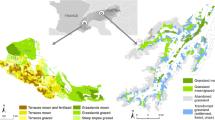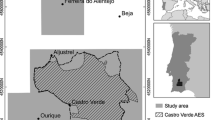Abstract
Landscapes undergo changes in structure and function at multiple temporal and spatial levels. As a consequence of natural and anthropogenic drivers, these changes affect options for land use. We describe winter land use by reindeer husbandry in the boreal forest in Northern Sweden. The landscape changes in its suitability for husbandry practices due to environmental stochasticity and transformations due to other forms of land use. This creates structures that can either (i) promote flexibility in the form of mobility or (ii) create fragmentation that restricts adaptation to changes. As these drivers are interdependent in their influence on land use practices by reindeer herders, different choices regarding husbandry strategies have to be made within a season and between years. To allow such choices and ensure pastoral resilience to change, boreal forests should be regulated to provide continuity of grazing resources at multiple temporal and spatial levels.


Similar content being viewed by others
References
Adger, W. N. (2006). Vulnerability. Global Environmental Change 16: 268–281.
Armitage, D., de Loë, R., and Plummer, R. (2012). Environmental governance and its implications for conservation. Conservation Letters 5: 245–255.
Axelsson, P., and Sköld, P. (2006). Indigenous Populations and Vulnerability. Characterizing Vulnerability in a Sami Context. Annales de démographie historique 111: 115–132.
Berkes, F., and Folke, C. (eds.) (1998). Linking Social and Ecological Systems. Cambridge University Press, Cambridge.
Bostedt, G., Parks, P. J., and Boman, M. (2003). Integrated Natural Resource Management in Northern Sweden: An Application to Forestry and Reindeer Husbandry. Land Economics 79: 149–159.
Brännlund, I., and Axelsson, P. (2011). Reindeer management during the colonization of Sami lands: A long-term perspective of vulnerability and adaptation strategies. Global Envirnomental Change 21: 1095–1105.
Brunetta, G., and Voghera, A. (2008). Evaluating Landscape for Shared Values: Tools, Principles, and Methods. Landscape Research 33: 71–87.
CAB in Norrbotten and SFA (2006). Skogen i Jokkmokks kommun: Metoder och underlagsmaterial för beskrivning av skogslandskapet. Rapportserie nummer 7/2006. The CAB in Norrbotten, Luleå.
Cash, D. W., Adger, W. N., Berkes, F., Garden, P., Lebel, L., Olsson, P., Pritchard, L., and Young, O. (2006). Scale and Cross-Scale Dynamics: Governance and Information in a Multilevel World. Ecology and Society 11: 8.
Chapin, F. S., Kofinas, G. P., and Folke, C. (eds.) (2009). Principles of Ecosystem Stewardship. Springer, New York.
Conrad, E., Christie, M., and Fazey, I. (2011). Is research keeping up with changes in landscape policy? A review of the literature. Journal of Environmental Management 92: 2097–2108.
Dettki, H., and Esseen, P.-A. (2003). Modeling long-term effects of forest management on epiphytic lichens in northern Sweden. Forest Ecology and Management 175: 223–238.
Dietz, T., Ostrom, E., and Stern, P. C. (2003). The Struggle to Govern the Commons. Science 302: 1907–1912.
Drever, C. R., Peterson, G., Messier, C., Bergeron, Y., and Flannigan, M. (2006). Can forest management based on natural disturbances maintain ecological resilience? Canadian Journal of Forest Research 36: 2285–2299.
Ericsson, S., Östlund, L., and Axelsson, A.-L. (2000). A forest of grazing and logging: Deforestation and reforestation history of a boreal landscape in central Sweden. New Forests. 19: 227–240.
Esseen, P.-A., Ehnström, B., Ericson, L., and Sjöberg, K. (1997). Boreal Forests. Ecological Bulletins 46: 16–47.
Fahrig, L. (2003). Effects of Habitat Fragmentation on Biodiversity. Annual Review of Ecology, Evolution, and Systematics. 34: 487–515.
Fels, J., and Wood, D. (2008). The Natures of Maps- Cartographic Constructions of the Natural World. University of Chicago Press, Chicago.
Fernandez-Gimenez, M. E. (2002). Spatial and social boundaries and the paradox of pastoral land tenure: a case study from postsocialist Mongolia. Human Ecology 30: 49–78.
Fernandez-Gimenez, M. E., and Le Febre, S. (2006). Mobility in pastoral systems: Dynamic flux or downward trend? International Journal of Sustainable Development and World Ecology 13: 341–362.
Fratkin, E. (1997). Pastoralism: Governance and development issues. Annu. Rev. Anthropol. 26: 235–261.
Galvin, K. (2009). Transitions: Pastoralists living with Change. Annual Review of Anthropology 38: 185–198.
Greider, T., and Garkovich, L. (1994). Landscapes: the social construction of nature and the environment. Rural Sociology 59: 1–24.
Haila, Y. (2007). Enacting Landscape Design: from Specific Cases to General Principles. In Lindenmayer D.B., and Hobbs, R.J. (eds.) Landscapes for conservation: moving from perspectives to principles. Blackwell Publishing, pp. 22–34.
Helle, T. (1984). Foraging behaviour of the semi-domesticated reindeer (Rangifer tarandus L.) in relation to snow in Finnish Lapland. Reports from the Kevo Subarctic Research Station 19: 35–47.
Hobbs, N. T., Galvin, K. A., Stokes, C. J., Lackett, J. M., Ash, A. J., Boone, R. B., Reid, R. S., and Thornton, P. K. (2008). Fragmentation of rangelands: Implications for humans, animals, and landscapes. Global Environmental Change 8: 776–785.
Horstkotte, T., and Roturier, S. (2013). Does forest stand structure impact the dynamics of snow on winter grazing grounds of reindeer (Rangifer t. tarandus)? Forest Ecology and Management 291: 162–171.
Horstkotte, T., Moen, J., Lämås, T., and Helle, T. (2011). The Legacy of Logging—Estimating Arboreal Lichen Occurrence in a Boreal Multiple-Use Landscape on a Two Century Scale. PLoS ONE 6: e28779 doi:10.1371/journal.pone.0028779.
Jonsson Cabrajic, A., Moen, J., and Palmqvist, K. (2010). Predicting growth of mat-forming lichens on a landscape scale – comparing models with different complexities. Ecography 33: 949–960.
Jougda, L., Näsholm, B., Sandström, P., and Sjöström, Å. (2011). Upprättade renbruksplaner 2005–2010. Rapport 6, Skogsstyrelsen.
Kendrick, A., and Manseau, M. (2008). Representing Traditional Knowledge: Resource Management and Inuit Knowledge of Barren-Ground Caribou. Society and Natural Resources 21: 404–418.
Kitchin, R., Perkins, C., and Dodge, M. (2011). Thinking about maps. In Dodge, M., Kitchin, R., and Perkins, C. (eds.), Rethinking maps: new frontiers in cartographic theory. Routledge Studies in Human Geography (28). Routledge, London, pp. 1–25.
Kivinen, S., Moen, J., Berg, A., and Eriksson, Å. (2010). Effects of Modern Forest Management on Winter Grazing Resources for Reindeer in Sweden. Ambio 39: 269–278.
Kivinen, S., Berg, A., Moen, J., Östlund, L., and Olofsson, J. (2012). Forest Fragmentation and Landscape Transformation in a Reindeer Husbandry Area in Sweden. Environmental Management 49: 295–304.
Korosuo, A., Sandström, P., Öhman, K., and Eriksson, L. (2013). Impacts of different forest management scenarios on forestry and reindeer husbandry. Scandinavian Journal of Forest Research doi:10.1080/02827581.2013.865782.
Kumpula, J., and Colpaert, A. (2007). Snow conditions and usability value of pastures for semi-domesticated reindeer (Rangifer tarandus tarandus) in pine forest landscape. Rangifer 27: 25–39.
Kvale, S. (1997). Den kvalitativa forskningsintervjun. Studentliteratur AB.
Langston, N. (2013). Mining the Boreal North. American Scientist 101: 98–102.
Lantto, P., and Mörkenstam, U. (2008). Sami Rights and Sami Challenges. Scandinavian Jouranl of History 33: 26–51.
Leach, M., Mearns, R., and Scoones, I. (1999). Environmental Entitlements: Dynamics and Institutions in Community-Based Natural Resource Management. World Development. 27: 225–247.
Loehle, C., MacCracken, J. G., Runde, D., and Hicks, L. (2002). Forest Management at Landscape Scales - Solving the Problems. Journal Forestry 100: 25–33.
Millennium Ecosystem Assessment (2005). Ecosystems and Human Well-being: Synthesis. Island Press, Washington, DC.
Mitchell, D. (2003). Dead labor and the political economy of landscape - California living, California dying. In Anderson, K., Domosh, M., Pile, S., and Thrift, N. (eds.), Handbook of Cultural Geography. Sage, London, pp. 233–248.
Moen, J., and Keskitalo, E. C. H. (2010). Interlocking panarchies in multi-use boreal forests in Sweden. Ecology and Society 15: 17.
Nelson, D. R., Adger, W. N., and Brown, K. (2007). Adaptation to environmental change: contributions of a resilience framework. Annual Review of Environment and Resources 32: 395–419.
Niamir-Fuller, M. (1998). The resilience of pastoral herding in Sahelian Africa. In Berkes, F., and Folke, C. (eds.), Linking Social and Ecological Systems. Cambridge University Press, Cambridge, pp. 250–284.
Olwig, K. (2007). The practice of landscape ‘Conventions’ and the just landscape: The case of the European landscape convention. Landscape Research 32: 579–594.
Opdam, P., Steingröver, E., and van Rooij, S. (2005). Ecological networks: a spatial concept for multi-actor planning for sustainable landscapes. Landscape and Urban Planning 75: 322–332.
Ostlund, L., Zackrisson, O., and Axelsson, A.-L. (1997). The history and transformation of a Scandinavian boreal forest landscape since the 19th century. Canadian Journal of Forest Research 27: 1198–1206.
Ostrom, E. (2007). A diagnostic approach for going beyond panaceas. Proceedings of the National Academy of Sciences 104: 15181–15187.
Parrott, L., and Meyer, W. S. (2012). Future landscapes: managing within complexity. Frontiers in Ecology and the Environment 10: 382–389.
Plummer, R., and Armitage, D. R. (2010). Integrating perspectives on adaptive capacity and environmental governance. In Armitage, D., and Plummer, R. (eds.), Adaptive capacity and environmental governance. Springer Verlag, Berlin, pp. 1–19.
Plummer, R., Armitage, D. R., and de Loë, R. C. (2013). Adaptive co-management and its relationship to environmental governance. Ecology and Society 18: 21.
Pretzsch, H., Grote, R., Reineking, B., Rötzer, T., and Seifert, S. (2008). Models for Forest Ecosystem Management: A European Perspective. Annals of Botany 101: 1065–1087.
Puettman, K., Coates, K. D., and Messier, C. (2008). A Critique of Silviculture - Managing for Complexity. Island Press, Washington.
Rees, W., Stammler, F., Danks, F., and Vitebsky, P. (2008). Vulnerability of European reindeer husbandry to global change. Climatic Change 87: 199–217.
Roturier, S., and Roué, M. (2009). Of forest, snow and lichen: Sámi reindeer herders’ knowledge of winter pastures in northern Sweden. Forest Ecology and Management 258: 1960–1967.
Sandström, C., and Widmark, C. (2007). Stakeholders’ perceptions of consultations as tools for co-management — A case study of the forestry and reindeer herding sectors in northern Sweden. Forest Policy and Economics 10: 25–35.
Sandström, P., Pahlén, T. G., Edenius, L., Tømmervik, H., Hagner, O., Hemberg, L., Olsson, H., Baer, K., Stenlund, T., and Brandt, L. G. (2003). Conflict resolution by partic-ipatory management: remote sensing and GIS as tools for communicating landuse needs for reindeer herding in northern Sweden. Ambio 8: 557–567.
Sandström, C., Moen, J., Widmark, C., and Danell, Ö. (2006). Progressing toward co-management through collaborative learning: forestry and reindeer husbandry in dialogue. International Journal of Biodiversity Science, Ecosystem Services and Management 2: 326–333.
Setten, G., Stenseke, M., and Moen, J. (2012). Ecosystem services and landscape management: three challenges and one plea. International Journal of Biodiversity Science, Ecosystem services and Management 8: 305–312.
SSR (2012). SSRs policydokument inför framtagandet av en ny samepolitk [SSRs policy document for new Sámi politics]. Retrieved 8th November 2012 from www.sapmi.se.
Stenseke, M., and Jones, M. (2011). Conclusion: Benefits, Difficulties, and Challenges of Participation Under the European Landscape Convention. In Jones, M., and Stenseke, M. (eds.), The European Landscape Convention – Challenges of Participation, Springer, pp. 297–309.
Turner, B. L., Matson, P. A., McCarthy, J. J., Corell, R. W., Christensen, L., Eckley, N., Hovelsrud-Broda, G. K., Kasperson, J. X., Kasperson, R. E., Luers, A., et al. (2003). A framework for vulnerability analysis in sustainability science. Proceedings of the National Academy of Sciences 100: 8074–8079.
Upton, C. (2012). Managing Mongolia’s Commons: Land Reforms, Social Contexts, and Institutional Change. Society and Natural Resources 25: 156–175.
Wheatley, S. (2003). Deliberative Democracy and Minorities. European Journal of International Law 14: 507–527.
Widmark, C. (2009). Management of multiple-use commons – focusing on land use for forestry and reindeer husbandry in northern Sweden. Doctoral Thesis. Swedish University of Agricultural Sciences, Umeå.
Widmark, C., Bosted, G., Andersson, M., and Sandström, C. (2013). Measuring transaction costs incurred by landowners in multiple land-use situations. Land Use Policy 30: 677–684.
Yaffee, S. (2011). Collaborative Strategies for Managing Animal Migrations: Insights from the History of Ecosystem-based Management, retrieved from http://www.lclark.edu/live/files/8529–412yaffee. 2012–02–07.
Acknowledgments
We thank Lars-Evert Nutti from Sirges for sharing his knowledge and experiences. Two anonymous reviewers gave constructive comments that substantially increased the quality of the manuscript. This study was supported financially by the Swedish Research Council for Environment, Agricultural Sciences and Spatial Planning FORMAS to Jon Moen and by grants from the Göran Gustafssons Stiftelse för Natur och Miljö i Lappland to Tim Horstkotte.
Author information
Authors and Affiliations
Corresponding author
Rights and permissions
About this article
Cite this article
Horstkotte, T., Sandström, C. & Moen, J. Exploring the Multiple Use of Boreal Landscapes in Northern Sweden: The Importance of Social-Ecological Diversity for Mobility and Flexibility. Hum Ecol 42, 671–682 (2014). https://doi.org/10.1007/s10745-014-9687-z
Published:
Issue Date:
DOI: https://doi.org/10.1007/s10745-014-9687-z




